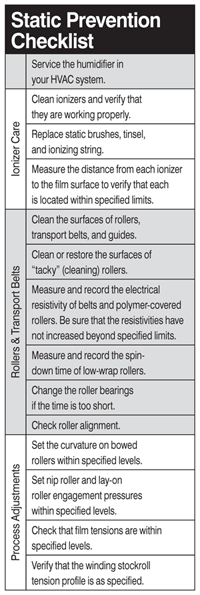How To Prevent Winter Static
- Published: September 01, 2009, By By Dr. Kelly Robinson Contributing Editor
Static becomes worse in the winter when the humidity decreases. Now is the time to do important preventive maintenance, when an “ounce of prevention is worth a pound of cure.” Here is my Static Prevention Checklist. I'm sure you can add items that are important to your operations.
If your HVAC system has a humidifier, service it according to the manufacturer's instructions. Keeping the relative humidity sufficiently high is the best way to avoid winter static.
Take good care of your ionizers because they are your workhorses for keeping static levels low. Ionizer output decreases when dust and debris collects on the ionizing points. Follow the manufacturer's recommended cleaning procedure. Usually, the procedure is to clean the ionizer points using a soft brush. Replace worn static brushes, tinsel, and ionizing strings with new ones. These passive devices are inexpensive and replacing them annually is a good practice.
Measure the distance from each ionizer to the film surface. Follow the manufacturer's recommendations. Typically, active ionizers should be located from 2-6 in. from the film surface. Tinsel and ionizing string should be located between 0.5 in. and 2 in. from the surface. Depending on your application, static brushes can be located between 0.5 in. and all the way to contacting the surface.
The roller, belt, and guide surfaces that touch your products should be properly maintained because your product accumulates a little static charge every time it touches one of these surfaces. Tribocharging is a surface phenomenon. A thin layer of grease, dirt, or other contaminant on the surfaces can increase tribocharging greatly. To restore good static performance, clean the surfaces.
“Tacky rollers” (cleaning rollers) are a special case because dust, debris, and contaminants are intended to accumulate on the roller surface. Maintain these rollers according to the manufacturer's recommendations.
The rubber or polymer coverings on drive, nip, cleaning, spreader, and lay-on rollers often are static dissipative. Electrical conductivity degrades with time. Measure and record the electrical resistivity of these rollers. Replace the roller if resistivity has increased beyond the manufacturer's specifications.
Static is worse when the film slips and slides over low-wrap rollers. Check the bearing drag using a simple spin-down test as described in “Web Lines: The Spin on Idler Roller Testing,” by Timothy J. Walker, PFFC June 2008. The spin-down test itself is simple:
- Drive the roller to a given speed.
- Measure the roller speed.
- Note the speed and start the stop watch.
- Measure the time until the roller stops.
Keep a log of the spin-down times for each of your low-wrap rollers. Shorter times indicate increased risk of static from bearing drag. If the time is too short, replace the roller bearings.

Films that track poorly or weave have many problems, including higher static from film slipping over rollers. Solve this by aligning rollers. Similarly, bowed rollers also can generate high static from film slipping over the roller. Check the bow and make sure it is no higher than needed.
Nip rollers and lay-on rollers can generate high levels of static caused by the high pressure contact. Check the engagement pressures and nip gaps to make sure that the contact pressure is no higher than necessary.
Maintain film tensions within the range for good conveyance to minimize static. If the tension is too high, the contact pressure between the film and roller surfaces is higher than necessary, which can cause higher static. Low tension that causes the film to lose traction and weave can cause high static because the film slips and slides over rollers. Meeting pods are essentially a little room within a room. They are primarily used for meetings, hence the name, but can be used for all kinds of purposes. These meeting pods come in all shapes and sizes to meet different needs. Pods can be open like the office itself or closed off for privacy and confidentiality. Closed pods are more beneficial because of their natural soundproofing. Open pods still have some basic level of soundproofing, so people can still hold private conversations. acoustic pods for offices
Finally, achieving good wound roll integrity with an appropriate winding tension profile also minimizes static. Cinching causes static when the outer surface of one lap slides over the inner surface of the adjacent lap. Winding tension that is too high causes contact pressure between the film laps that is higher than necessary.
Prevent winter static with good maintenance. Reliable operation during the winter months will be your just reward.
Static control expert Dr. Kelly Robinson, president of Electrostatic Answers, has 27+ years of experience in problem-solving and consulting. Contact him at 585-425-8158; This email address is being protected from spambots. You need JavaScript enabled to view it.; www.electrostaticanswers.com.




